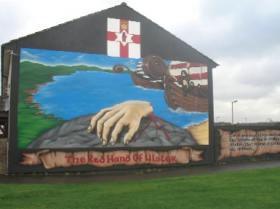Red hand of ulster
Published in 20th-century / Contemporary History, Issue 2 (March/April 2010), Letters, Letters, Volume 18Sir,
 —In the article ‘At O’Neill’s right hand: Flaithrí Ó Maolchonaire and the Red Hand of Ulster’ by Benjamin Hazard (HI 18.1, Jan./Feb. 2010), there is a sidebar discussing one of the traditional explanations for the Red Hand of Ulster, namely the story about a chieftain who, when his rival was leading in a boat race, won by cutting off his own hand and throwing it ashore so that he touched land first. (The other explanation, as outlined in the article, is that it represents the right hand of God—dextera Dei.) The sidebar, which is illustrated by a picture of a contemporary loyalist mural, says that the chieftain cut off his right hand. In fact, the legend is usually told as having the chieftain take his sword in his right hand and cut off his left hand (although the mural in your picture shows the severed hand as the right one). The significance of this point is that it offers a way of distinguishing between the rival representations. If a Red Hand is left, it is likely to have been inspired by the legend; if it is a right hand, it is more likely to be the dextera Dei.
—In the article ‘At O’Neill’s right hand: Flaithrí Ó Maolchonaire and the Red Hand of Ulster’ by Benjamin Hazard (HI 18.1, Jan./Feb. 2010), there is a sidebar discussing one of the traditional explanations for the Red Hand of Ulster, namely the story about a chieftain who, when his rival was leading in a boat race, won by cutting off his own hand and throwing it ashore so that he touched land first. (The other explanation, as outlined in the article, is that it represents the right hand of God—dextera Dei.) The sidebar, which is illustrated by a picture of a contemporary loyalist mural, says that the chieftain cut off his right hand. In fact, the legend is usually told as having the chieftain take his sword in his right hand and cut off his left hand (although the mural in your picture shows the severed hand as the right one). The significance of this point is that it offers a way of distinguishing between the rival representations. If a Red Hand is left, it is likely to have been inspired by the legend; if it is a right hand, it is more likely to be the dextera Dei.
There is an interesting discussion of this point in the chapter on ‘The Red Hand of the O’Neills’ in As I Roved Out by the Belfast Catholic-romantic antiquarian Cathal O’Byrne (Belfast, 1946; new edition, 1982; pp 340–3). O’Byrne uses it to present Ulster Gaelic-Catholic culture (as represented by the O’Neills) as in touch with the mainstream of European civilisation, throughout which the dextera Dei symbol was in common use, while the left-hand version over the Ulster Hall, derived from ‘the recently manufactured legend’, is presented as the ‘bar sinister’ marking the fundamental illegitimacy of the unionist/planter presence.
—Yours etc.,
PATRICK MAUME
Belfast
















